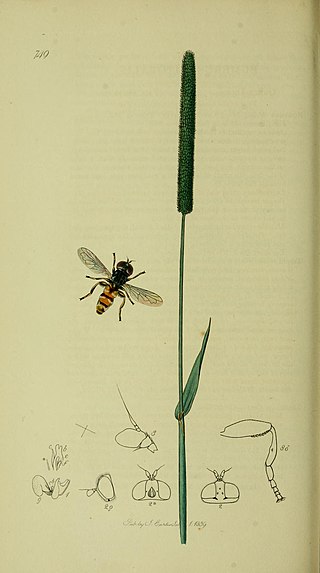Related Research Articles

Hover flies, also called flower flies or syrphid flies, make up the insect family Syrphidae. As their common name suggests, they are often seen hovering or nectaring at flowers; the adults of many species feed mainly on nectar and pollen, while the larvae (maggots) eat a wide range of foods. In some species, the larvae are saprotrophs, eating decaying plant and animal matter in the soil or in ponds and streams. In other species, the larvae are insectivores and prey on aphids, thrips, and other plant-sucking insects.

Helophilus are a diverse genus of moderate to large hoverflies, that appear somewhat bee-like. Larvae filter-feed in organic rich water. All Helophilus adults have a distinctive lengthwise striped thorax and a transverse striped abdomen.

Eumerus is a genus of hoverflies, within the tribe Eumerini.

Xanthandrus is a small genus of hoverflies.

Doros is a genus of hoverflies. They are large slender flies, that mimic solitary wasp in slow flight. They have very limited flight period.

Callicera is a Holarctic genus of hoverflies

Portevinia is a genus of hoverflies. There is only one European species - P. maculata.
Hammerschmidtia is a Holarctic genus of hoverflies whose larvae live in sap under the bark of freshly fallen trees.

Lejogaster is a genus of small, shiny, metallic hoverflies.

Myolepta is a cosmopolitan genus of hoverflies most closely related to the genus Lepidomyia

These are small black and yellow or mostly black flies with a narrow abdomen near the thorax. They occur mainly in damp places among low herbage. The larva of Neosascia are flattened without oral hooks and a have a short posterior spiracular process or "tail" rat-tailed that is saprophagous. In 1925 Curran reviewed the genus Neoascia. In this work a key is provided and ten species are described including four new species some of which have later been determined to be synonyms.

Riponnensia is a genus of hoverflies.

Sercomyia are large flies with species that are bee mimics both short pile and long pile. Sericomyiine flower flies are common in boreal forests across the Holarctic region and southward at higher elevations into the Oriental and Neotropical regions. Sericomyia species have larvae of the rat-tailed maggot type, often found in ponds rich in decomposing vegetation where they filter out microorganisms as their food

Brachypalpus is a genus of hoverflies, from the family Syrphidae, in the order Diptera. The head is triangular and produced well forwards and somewhat downwards. The thorax and abdomen with pile often rather long. The hind femur is swollen and with an obtuse spur apically and ventrally. The hind trochanters of male is spurred.
The larvae are of the rat-tailed type feeding on decaying sap under tree bark. Larvae live in decaying trees and logs. Larva and pupa have been described by Malloch.

Eumerus ornatus is a species of hoverfly, from the family Syrphidae, in the order Diptera.

The Eumerini is a tribe of hoverflies. The breeding habits of this group varies: larvae of the genera Merodon and Eumerus tunnel into plant bulbs while larvae of Psilota have been found in sap runs.

Eumerus funeralis or lesser bulb fly is a species of Hoverfly, from the family Syrphidae, in the order Diptera. E. funeralis appears in Peck (1988) as a synonym of E. strigatus (Fallen), but was reinstated as the correct name for tuberculatus Rondani, sensu auctorum by Speight et al. (1998).

Eumerus sabulonum is a species of hoverfly, from the family Syrphidae, in the order Diptera.

Eumerus strigatus ,, the Onion Bulb Fly , is a fairly common species of syrphid fly observed acoss Europe. Also found in north-central North America and other scattered locations as an introduced species from infested bulbs. Syrphid flies are also known as Hover Flies or Flower Flies because the adults are frequently found hovering around flowers from which they feed on nectar and pollen. The larvae feed on various bulbs. .
References
- ↑ Barkalov, A.V. "Collection of Siberian Zoological Museum: Syrphidae". Siberian Zoological Museum. Archived from the original on 20 October 2008. Retrieved 19 July 2013.
- ↑ Stubbs, Alan E.; Falk, Steven J. (1983). British Hoverflies: An Illustrated Identification Guide. British Entomological & Natural History Society. pp. 253, xvpp.
- ↑ Van Veen, M.P. (2004). Hoverflies of Northwest Europe, Identification Keys to the Syrphidae (hardback). Utrecht: KNNV Publishing. p. 254. ISBN 978-90-5011-199-7.